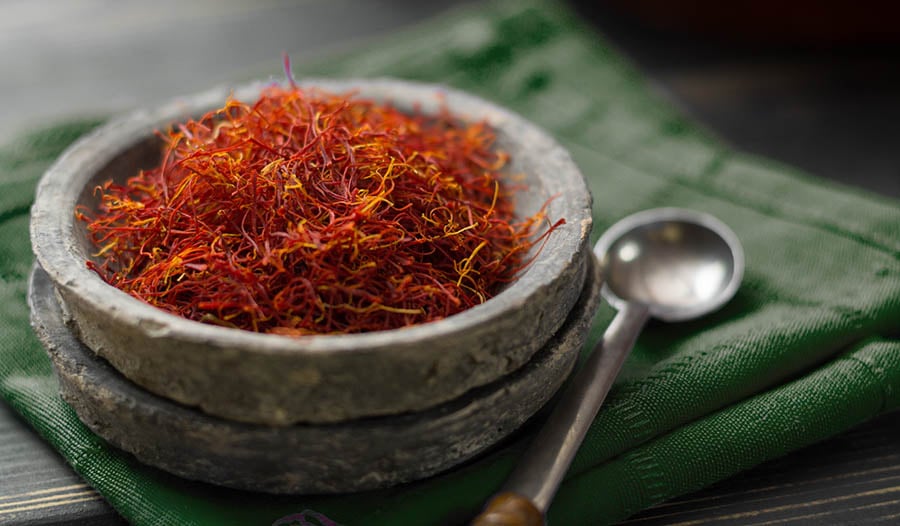藏紅花:維護神經精神健康的天然方法

可以使用的主流療法具有局限性,這使得有證據支持的補充性及替代性(CAM)療法出現了。
效果有限、安全問題以及許多精神性藥劑的高成本讓更安全、更有效、價格更實惠的精神疾病療法成為一個迫切的問題。經過數十年以及數十億美元的工業資金投入後,支持廣泛使用藥劑緩解抑鬱症、躁鬱症、精神分裂症和其它精神疾病的證據不再令人信服了。這些問題導致越來越多有精神健康問題的人從補充性及替代性醫學(CAM)實踐者——包括中醫實踐者、自然療法醫生、草藥師、按摩療法醫生、順勢療法醫生和其它實踐者——那裡尋求療法。隨著人們對綜合精神健康護理的關注越來越高,藏紅花作為一種針對各種神經精神疾病的有希望的方法出現了。
藏紅花與多種神經精神疾病的療法
藏紅花(番紅花)具有刺激性慾、祛痰、止痙攣、消毒和促進認知的作用,因而其在波斯醫學和中醫中有很長的使用歷史。藏紅花對情緒低落、阿爾茲海默症和注意力缺乏多動症(注意力不集中症)可能具有有益的效果,這種效果得到累積的人類研究結果的支持。動物研究結果顯示,藏紅花也可能對被診斷患有焦慮症、精神分裂症和強迫症(OCD)的人具有有益的效果。藏紅花的生物活性組分可能可以增加多巴胺和去甲腎上腺素的再攝取遏制,並可能可以作為N-甲基D-天門冬氨酸(NMDA)受體拮抗體和GABA致效劑發揮作用。本篇短文的其餘部分將簡單回顧藏紅花對情緒低落、阿爾茲海默症、注意力缺乏多動症(注意力不集中症)的效果的研究發現。
藏紅花與情緒低落
藏紅花的抗抑鬱益處可能是由於它所具有的多種機制,包括它在激活血清素、防氧化、防炎性、神經內分泌和神經保護方面所起的作用。對6項針對藏紅花對輕度至中度情緒低落的效果的安慰劑對照研究進行了一次系統回顧並得出結論,藏紅花和抗憂鬱劑的效力相當。2019年一項包括11項針對藏紅花對輕度至中度情緒低落人士的效果的安慰劑對照研究(總樣本數大於500)在內的薈萃分析得出結論,藏紅花的效果明顯優於安慰劑,並且與選擇性血清素再吸收遏製劑類的抗抑鬱藥(氟西汀和西酞普蘭)的效力相當。藏紅花與安慰劑的不良效果的發生率沒有區別,甚至在使用高劑量藏紅花(每天達到1.5毫克)的研究中也是如此。薈萃分析中所包含的全部研究都在伊朗進行,藏紅花在那里傳統上被用來緩解情緒低落和各種病症。另外,許多患者患有並存病。這兩個因素可能會讓結論存在偏頗。需要由獨立研究團體進行大型安慰劑對照試驗,以確認這些發現並確定最佳劑量和療程。新的發現顯示,不管是作為單一療法還是抗抑鬱劑的輔助療法,薑黃素(來自薑黃)都具有抗抑鬱的效果。也有證據顯示,薑黃素與藏紅花的結合可能會產生協同的抗抑鬱益處。在一項為期12週的雙盲安慰劑對照研究中,與安慰劑對照組相比,隨機使用低劑量薑黃素提取物(每天兩次,每次250毫克)、高劑量薑黃素提取物(每天兩次,每次500毫克)或結合使用低劑量的薑黃素與藏紅花(每天兩次,每次15毫克)的重度抑鬱症患者在情緒方面得到顯著的改善。需要進行更多研究來確定這些草本產品的不同劑量是否會產生不同的抗抑鬱效果。
藏紅花的培植和採摘是勞動密集型工作,需要花上數百個小時手工採摘數千朵花朵的柱頭。其結果就是世界市場上優質藏紅花的高成本和有限的供應量。為努力找到一種高產出、低成本來源的藏紅花,研究者提取了藏紅花球莖的數種活性組分,並研究了它們對老鼠情緒低落的行為模式的影響。研究者確認了兩種生物活性組分,它們對抑鬱症的效力可能可以與來自柱頭的藏紅花的效力相當。需要進行安慰劑對照試驗,以確認該發現也適合患抑鬱症的人士。
藏紅花與註意力不集中症
包括哌醋甲酯在內的興奮劑和其它被廣泛使用緩解注意力不集中症的藥劑會造成副作用,如失眠、食慾減退和腹痛。緩解成人注意力不集中症的興奮劑和其它藥劑療法所取得的效果可能只是它們對於兒童的效果的一半。對於這些問題的廣泛擔憂已經引起人們對有希望的天然產品和其它補充性與替代性方式進行研究。
藏紅花的生物活性組分可能可以增加多巴胺和去甲腎上腺素的再攝取遏制,並可能可以作為N-甲基D-天門冬氨酸(NMDA)受體拮抗體和GABA致效劑發揮作用。兩種機制都被認為對注意力不集中症的症狀具有有益的緩解效果。一項針對注意力不集中症兒童患者和青少年患者的為期6週的隨機雙盲研究發現顯示,藏紅花(每天20到30毫克)和哌醋甲酯(每天20到30毫克)的效力在家長和老師的症狀評估量表中相當。這一發現應被視為由大型且為期時間長的安慰劑對照研究做出的初步確認。
藏紅花與阿爾茲海默症
新的研究發現正在證實傳統醫學長期以來所宣稱的觀點,即藏紅花可能可以改善健康人士的認知功能,並且可能可以減輕阿爾茲海默症患者的認知障礙症狀。藏紅花促進認知的效果被認為是由防氧化成分和抗擊澱粉樣蛋白的活性予以調節的。針對藏紅花對阿爾茲海默症的效果的安慰劑對照研究結果一致報告了其對認知具有益處。在一項為期22週的安慰劑對照試驗中,55位輕度至中度阿爾茲海默症患者隨機使用藏紅花(每天兩次,每次15毫克)與多奈哌齊(醫生廣泛開具的一種膽鹼酯酶遏製劑,每天兩次,每次5毫克)。根據標準化症狀評估量表,該試驗顯示,藏紅花與多奈哌齊對於行為和認知功能的改善效果相當。阿爾茲海默症與情緒低落的高共病率讓藏紅花成為這些人群的合理選擇。
藏紅花、焦慮、精神分裂症與強迫症
除了其對情緒低落、阿爾茲海默症和注意力不集中症可能具有的有益效果,動物研究的新發現還顯示,藏紅花對焦慮症、精神病和強迫症的症狀可能具有有益效果。但是,到目前為止,在人類臨床試驗中尚未研究藏紅花對於這些疾病的效力。藏紅花生物活性組分的抗焦慮、抗精神病和抗強迫的一種或多種機制尚未被闡明,但是可能與GABA-A和N-甲基D-天門冬氨酸神經遞質系統有關。
藏紅花、防氧化成分與神經保護作用
可以使用的精神健康問題傳統療法具有局限性,這刺激了對於各種補充性與替代性(CAM)療法的研究。在其它非藥劑療法中,藏紅花作為緩解神經精神疾病的一種療法近年來越來越受到關注。研究結果顯示,藏紅花可能具有顯著的防氧化和神經保護作用,並且可能是緩解輕度至中度情緒低落、輕度至中度阿爾茲海默症的一種安全而有效的療法。一項最近的研究顯示,藏紅花在緩解注意力不集中症方面的效力與中樞神經興奮劑的效力相當。預臨床動物研究的初步結果顯示,藏紅花可能具有顯著的抗焦慮、抗精神病、抗強迫的效力。需要進行大型且為期時間長的安慰劑對照研究,以確認以上發現、確定理想的劑量以及研究藏紅花如何安全且適當地與其它天然產品和精神藥劑結合使用。
參考文獻:
- Akhondzadeh Basti A, Moshiri E, Noorbala AA, Jamshidi AH, Abbasi SH, Akhondzadeh S:Comparison of petal of Crocus sativus L. and fluoxetine in the treatment of depressed outpatients:A pilot double-blind randomized trial.Prog Neuropsychopharmacol Biol Psychiatry 31:439–442, 2007.
- Akhondzadeh S, Shafiee Sabet M, Harirchian MH, Togha M, Cheraghmakani H, Razeghi S, Hejazi SS, Yousefi MH, Alimardani R, Jamshidi AH, Zare F, Moradi A (2009) Saffron in the treatment of patients with mild to moderate Alzheimer's disease: a 16-week, randomized and placebo controlled trial.J Clin Pharm Ther
- Akhondzadeh, S. et al, A22-week, multicenter, randomized, double-blind controlled trial of Crocus sativus in the treatment of mild-to-moderate Alzheimer's disease, Psychopharmacology (2010) 207:637–643
- Barnes PM, Bloom B, Nahin RL.Complementary and alternative medicine use among adults and children:United States, 2007.Natl Health Stat Report 2008 Dec 10;(12):1-23.
- Baziar, S., Aqamolaei, A., Khadem, E., Mortazavi, S., Naderi, S. et al (2019) Crocus sativus L. Versus Methylphenidate in Treatment of Children with Attention-Deficit/Hyperactivity Disorder:A Randomized, Double-Blind Pilot Study.J Child Adolesc Psychopharmacol.29:3; 1-8.
- Berman SM, et al.Potential adverse effects of amphetamine treatment on brain and behavior: a review.Mol Psychiatry.2009;14(2):123–42.
- Denys, D., de Haan, L., (2008) [25 years antipsychotics: back to the future?][Article in Dutch] Tijdschr Psychiatr.2008;50 Spec no.:105-9.
- Fernandez JA (2004) Biology, biotechnology and biomedicine of saffron.Recent Res Dev Plant Sci 2:127–159.
- Fournier JC, DeRubeis RJ, Hollon SD, et al.Antidepressant drug effects and depression severity:A patient-level meta-analysis.JAMA 2010 Jan 6;303(1):47-53.
- Georgiadou G, Tarantilis PA, Pitsikas N. Effects of the active constituents of Crocus Sativus L., crocins, in an animal model of obsessive-compulsive disorder.Neurosci Lett.2012 Oct 18;528(1):27-30.
- Hartling L, Abu-Setta AM, Dursun S, Mousavi SS, Pasichnyk D, Newton AS.Antipsychotics in adults with schizophrenia:Comparative effectiveness of first-generation versus second-generation medications:A systematic review and meta-analysis.Ann Intern Med 2012 Oct 2;157(7):498-511.
- Herrmann N, Chau SA, Kircanski I, Lanctôt KL.(2011) Current and emerging drug treatment options for Alzheimer's disease:A systematic review.Drugs 22;71(15):2031- 65.
- Kanchanatawan B, Tangwongchai S, Sughondhabhirom A, Suppapitiporn S, Hemrunrojn S, Carvalho AF, Maes M. Add-on Treatment with Curcumin Has Antidepressive Effects in Thai Patients with Major Depression:Results of a Randomized Double-Blind Placebo-Controlled Study.Neurotox Res.2018 Apr;33(3):621-633.
- Kelley J. (2 March 2010) Antidepressants:Do they “work” or don't they?[Internet].New York, NY:Scientific American; 2010 Mar 2
- Kirsch I, Deacon BJ, Huedo-Medina TB, Scoboria A, Moore TJ, Johnson BT.(2008) Initial severity and antidepressant benefits:A meta-analysis of data submitted to the Food and Drug Administration.PLoS Med 5(2):e45.
- Lopresti AL, Drummond PD.Efficacy of curcumin, and a saffron/curcumin combination for the treatment of major depression:A randomised, double-blind, placebo-controlled study.J Affect Disord.2017 Jan 1;207:188-196.
- Lopresti AL, Drummond PD.Saffron (Crocus sativus) for depression: a systematic review of clinical studies and examination of underlying antidepressant mechanisms of action.Hum Psychopharmacol.2014 Nov;29(6):517-27.
- Lopresti AL, Maes M, Maker GL, Hood SD, Drummond PD.Curcumin for the treatment of major depression: a randomised, double-blind, placebo-controlled study.J Affect Disord.2014;167:368-75.
- Negbi M (1999) Saffron cultivation: past, present and future prospects.In:Negbi M (ed) Saffron Crocus sativus L. Harwood, Amsterdam, pp 1–17.
- Newcorn JH, et al.The complexity of ADHD: diagnosis and treatment of the adult patient with comorbidities.CNS Spectr.2007;12(8 Suppl 12):1–14.
- Papandreou MA, Kanakis CD, Polissiou MG, Efthimiopoulos S, Cordopatis P, Margarity M, Lamari FN (2006) Inhibitory activity on amyloid-beta aggregation and antioxidant properties of Crocus sativus stigmas extract and its crocin constituents.J Agric Food Chem 15:8762–8768
- Pitsikas N, Boultadakis A, Georgiadou G, Tarantilis PA, Sakellaridis N:Effects of the active constituents of Crocus sativus L., crocins, in an animal model of anxiety.Phytomedicine 15:1135–1139, 2008.
- Pitsikas N, Sakellaridis N:Crocus sativus L. extracts antagonize memory impairments in different behavioural tasks in the rat.Behav Brain Res 173:112–115, 2006.
- Pitsikas, N., Constituents of Saffron (Crocus sativus L.) as Potential Candidates for the Treatment of Anxiety Disorders and Schizophrenia Molecules.2016 Mar; 21(3):303.
- Rı´os JL, Recio MC, Giner RM, Ma´n˜ez S:An update review of saffron and its active constituents.Phytother Res 10:189–193, 1996.
- Schachter HM, et al.How efficacious and safe is short-acting methylphenidate for the treatment of attention-deficit disorder in children and adolescents?A meta-analysis.2001;165(11):1475–88.
- Schmidt M, Betti G, Hensel A (2007) Saffron in phytotherapy: pharmacology and clinical uses.Wien Med Wochenschr 157:315–319
- Srivastava R, Ahmed H, Dixit RK, Dharamveer, Saraf SA:Crocus sativus L.:A comprehensive review.Pharmacogn Rev 4:200–208, 2010.
- Stafford MR, Mayo-Wilson E, Loucas CE, et al.2015 Efficacy and safety of pharmacological and psychological interventions for the treatment of psychosis and schizophrenia in children, adolescents and young adults:A systematic review and meta-analysis.PloS One Feb 11;10(2):e0117166.
- Thase ME.STEP-BD and bipolar depression:What have we learned?Curr Psychiatry Rep 2007 Dec;9(6):497-503.
- Tóth B, Hegyi P, Lantos T, Szakács Z, Kerémi B, Varga G, Tenk J, Pétervári E, Balaskó M, Rumbus Z, Rakonczay Z, Bálint ER, Kiss T, Csupor D. The Efficacy of Saffron in the Treatment of Mild to Moderate Depression:A Meta-analysis.Planta Med.2019 Jan;85(1):24-31.
- Velligan DI, Weiden PJ, Sajatovic M, et al; Expert Consensus Panel on Adherence Problems in Serious and Persistent Mental Illness.The expert consensus guideline series:Adherence problems in patients with serious and persistent mental illness.J Clin Psychiatry 2009;70 Suppl 4:1-46.
- Wang et al (2010) Antidepressant properties of bioactive fractions from the extract of Crocus sativus L. J Nat Med (2010) 64:24–30.
- Wang Y, Han T, Zhu Y, Zheng CJ, Ming QL, Rahman K, Qin LP:Antidepressant properties of bioactive fractions from the extract of Crocus sativus L. J Nat Med 64:24–30, 2010.
- Xuabin N (1992) Research progresses on the saffron crocus (Crocus sativus).Zhongcaoyao 23:100–107.
免責聲明:本健康中心不提供診斷⋯














































































 目錄
目錄


